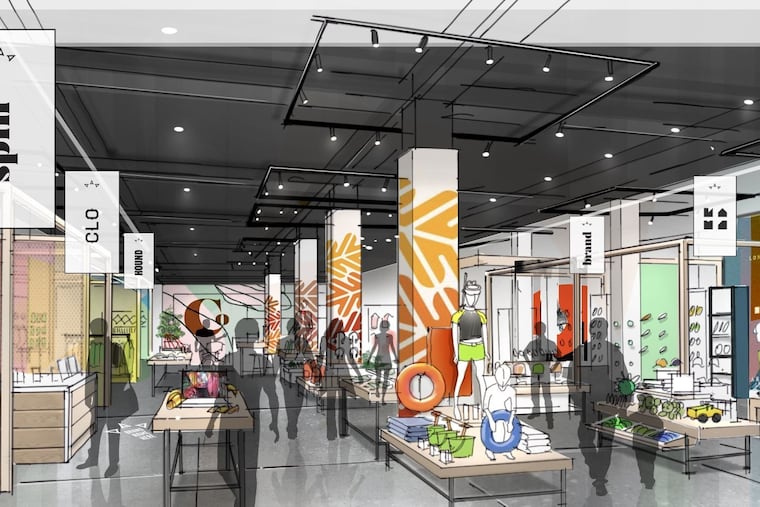Online brands to find brick-and-mortar home at Center City’s former Gallery mall
Anchor Shops and similar ventures are the latest step in the evolving relationship between web-based brands and shopping-mall owners, as e-commerce continues to reshape the retail industry.

The Center City mall now known as Fashion District Philadelphia already has an As Seen on TV store.
Coming soon: a shop that could deserve the nickname As Seen on the Internet.
Anchor Shops — as it’s actually called — is set to open by the end of spring, selling housewares, clothing, and other goods now peddled by an array of online retailers recruited to sublease space at the store.
ShopFulfill Corp., Anchor’s parent, will handle logistics for those sellers, warehousing their merchandise in part of the former Macy’s store in South Jersey’s Moorestown Mall for shipment to the Fashion District and as many as a dozen other locations in coming years.
The enterprise and others like it represent the latest step in the evolving relationship between web-based brands and shopping mall owners, as e-commerce continues to reshape the retail industry.
“Online retailers and in-store retailers and landlords have all come to the conclusion that we’re in this thing together,” said Joseph Coradino, chief executive of Pennsylvania Real Estate Investment Trust, which owns the Moorestown and Philadelphia malls. “We’re all trying to figure out how best to do business together."
Garrick Brown, a vice president for retail research with the real estate service firm Cushman & Wakefield, said he’s been seeing online sellers increasingly seek physical store space as a way to boost brand awareness and handle merchandise returns more efficiently.
Digitally native brands that have staked out a broad physical footprint include the clothing stores Bonobos and Untuckit and the eyeglass company Warby Parker, which have stores of their own in malls and on shopping streets.
Other digital natives have made their way into conventional stores, such as Harry’s Inc. shaving supplies, which are now sold at Target Corp. stores, and Kylie Jenner’s cosmetics brand, which has become available at Ulta Beauty Inc. locations.
Another iteration is Amazon.com Inc.'s chain of 4-Star stores, which sell highly ranked items from the e-commerce behemoth’s website.
Anchor Shops, however, belongs to a new breed of online-and-physical-hybrid stores that focus on smaller brands and start-ups, Brown said.
Other examples include Showfields in New York City, which intersperses pop-art exhibitions with stalls featuring design- and health-oriented online brands, and B8ta (pronounced “beta”), a tech-oriented marketplace with dozens of locations, including one at the King of Prussia Mall.
“It’s almost like a reimagining of the department store,” Brown said. “This is going to become more and more of a model for new brands and for start-ups to launch.”
The Anchor Shops store in the Fashion District, formerly known as the Gallery at Market East, will occupy a 7,000-square-foot space on the building’s concourse level, next to H&M and across from the City Winery wine counter, said Shlomo Chopp, ShopFulfill’s founder and chief executive.
Eight to 12 other stores are planned in Southeastern Pennsylvania and South Jersey in the coming years, Chopp said. Among them is to be an extra-large location at the Moorestown Mall, where the company’s 30,000-square-foot distribution center will be located in a still-vacant second-floor section of the retail center’s former Macy’s store, he said.
The Fashion District was selected for the chain’s first store because of its location in a densely peopled section of Center City, as well as its “captive audience” of shoppers who pass through the mall to board trains at SEPTA’s Jefferson Station Regional Rail stop on its concourse level, Chopp said.
He said he decided to concentrate his efforts on Greater Philadelphia because of market research showing that area residents are more likely to buy things at stores they visit — as opposed to merely browsing — than people in other regions.
“In Philadelphia, if you go shopping, you’re going to buy more than you are going to just look," he said.
The Fashion District store will feature about 1,400 items from 40 to 50 brands, ranging from “fashion to children’s wear to innovation technology,” Chopp said. Special effort will be made to recruit locally based brands, he said.
Brands will be required to first sign subleases of several months to use space in Anchor Shops stores but will be able to renew for periods of as little as a month at a time after that initial commitment, allowing them to gain a physical foothold in a market without renting and fitting out a location of their own, Chopp said.
He would not say whether any brands have yet signed on with the venture.
“There will be brands that you will recognize instantly, and there will be some you’ll want to go and look at and say, ‘What is this brand?' " Chopp said. “By bringing that mix together, our focus is to promote these brands.”